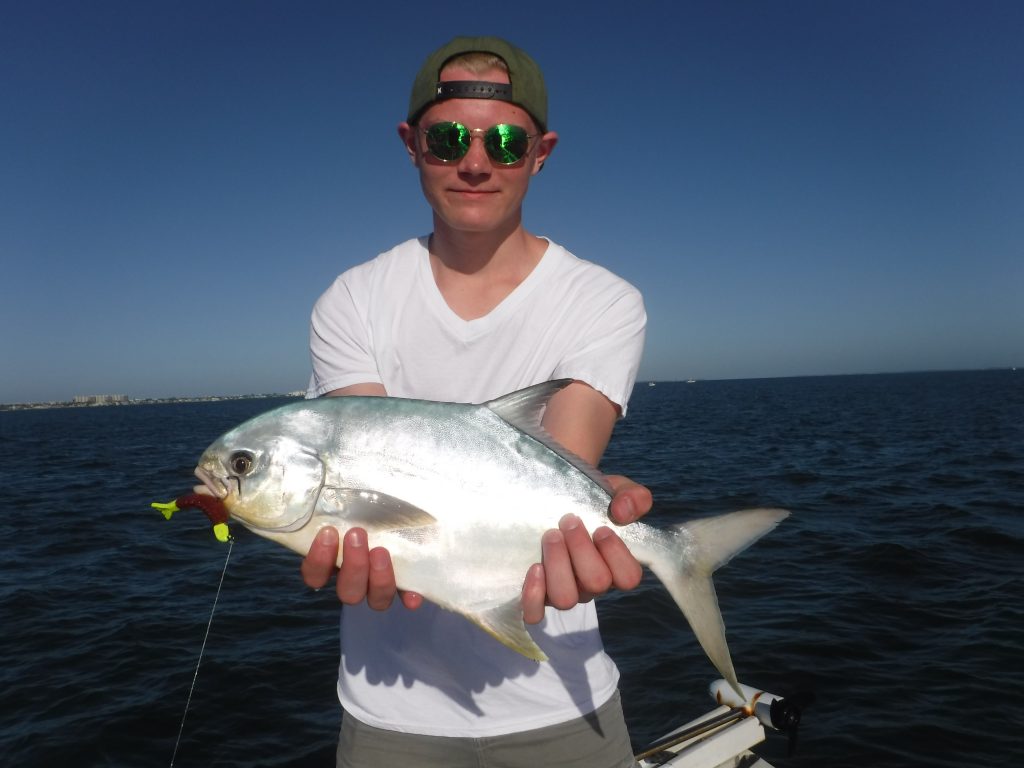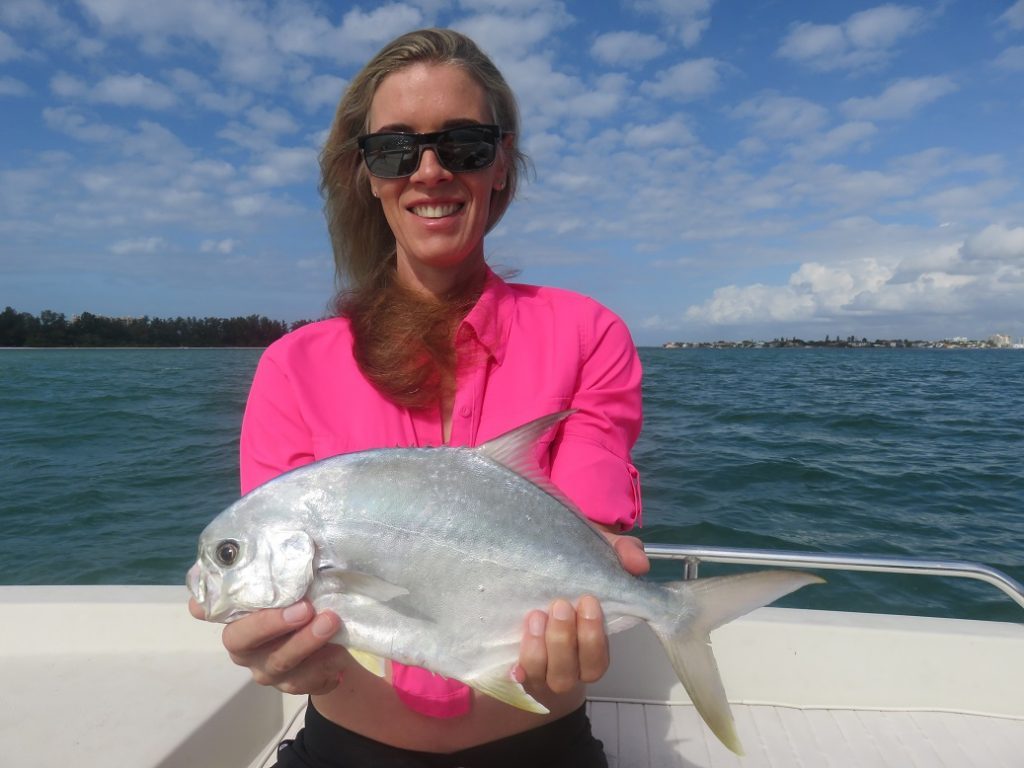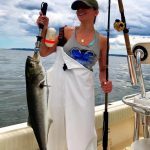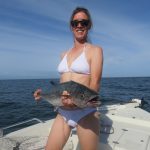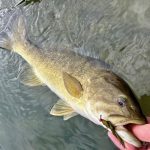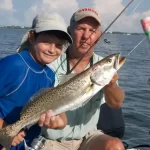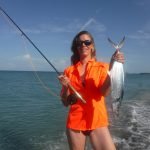Pompano Fishing in Florida, a Complete Guide
This article will thoroughly cover pompano fishing in Florida. Pompano fishing is very popular among saltwater anglers. They are one of the most desirable species for anglers along the coast from Texas to the Carolinas. However, Florida is the best state to target them in. These smaller cousins to the permit are very beautiful fish that fight incredibly hard for their size and taste great. Pompano are found in the inshore waters and in the surf along the coast. They can be caught by anglers using several different techniques.
Pompano, Trachinotus carolinus, have an inferior mouth. They root along the bottom in search of shrimp, crabs, and other crustaceans. Therefore, the best lures and baits are fished right on the bottom. Pompano are found along the entire coast of Florida, the Gulf Coast, and the southeast United States.They put up a terrific fight and are fantastic to eat!
Pompano can be taken on both live and artificial baits. In either case, the offering is presented right on the bottom where pompano feed. A moving bait or lure that bounces along the bottom is especially effective as it simulates fleeing prey.
Pompano fishing in Florida
Many pompano are caught by anglers in Florida do so surf fishing. Anglers also catch them both off of the beaches and in the inshore bays. Passes and inlets are prime spots to find pompano as well. Pompano may be encountered at any time of year. However, cooler months are generally the most productive times of year to catch pompano, though that does vary by region.
Pompano look very similar to juvenile permit. They also tend to live in the same environments. Permit have longer fins with a bit of black on the tips. If anglers have any doubt, it is best to err on the side of caution and release the fish.
Best pompano fishing tackle
As in most inshore saltwater applications, the same rod and reel used to target speckled trout, Spanish mackerel, and other species will work fine when targeting pompano. A light spinning outfit works best since pompano average two pounds. A 7 foot medium action rod with a 2500-3000 series reel and 10 pound monofilament or braided line is perfect. Below is the rod and reel combo that Capt Jim uses on his fishing charters.
Anglers can shop at Amazon for a Daiwa Black Gold reel and St Croix Triumph 7′ MF rod spinning combo in this link.
“Fishing Lido Key is a participant in the Amazon Associates Program, an affiliate advertising program designed to provide a means for sites to earn advertising fees by advertising and linking to Amazon. As an Amazon Associate I earn from qualifying purchases.”
Best pompano fishing lures
When it comes to pompano fishing lures, the jig is the preferred bait by Capt Jim and many other anglers. Jigs realistically mimic the crabs and other crustaceans that pompano feed on. The best pompano fishing lures are jigs with round or conical heads and a short, thick skirt. Banana jigs are odd looking baits that have a very erratic action as they fall. These are productive pompano fishing lures as well.
Jigs produce most of the pompano landed by anglers choosing to fish with artificial lures. A close look at a pompano will reveal a small, inferior mouth. The term inferior mouth refers to the fact that the opening of the mouth is on the underside of the head. This will indicate the method by which a pompano feeds. It swims with it’s head down and tail up, searching the bottom for crustaceans such as shrimp and crabs. When it comes to pompano fishing lures, the jig is the top bait.
This explains why jigs are so productive when targeting pompano. A jig that is bounced off the bottom kicks up a tiny puff of sand. This very closely mimics the action of a fleeing crab or shrimp. Jigs produce on the beach, in the passes, and in the bays. Bright colors such as red, chartreuse, and white are the most productive. Capt Jim uses them often on his Sarasota fishing charters.
Many anglers land pompano while casting 3 inch to 4 inch jigs while drifting over the deep grass flats. The Bass Assassin baits that work so well for speckled trout, bluefish, ladyfish, and other species will also fool pompano. The same jig and fall retrieve is productive. The deeper flats, those between 8 feet and 10 feet deep, produce more pompano. However, they can be encountered over sandbars in as little as 2 feet of water.
Small jigs are best for pompano fishing
While the larger jigs will catch the occasional pompano, when specifically targeting pompano, smaller lures are often used. Not surprisingly, these are called “pompano jigs”. As noted earlier, pompano have a quite small mouth, so a smaller bite-size jig works well. These jigs are very plain looking. There simply a round jig head with a little bit of dressing, usually synthetic care. Combinations of white, yellow, chartreuse, and red have proven to be effective colors.
There is another type of lure specifically designed to for anglers Florida pompano fishing. They are called “banana jigs”. They are long and slender, and shaped like a banana, thus the name. When jerked up sharply, they fall in a very erratic manner. Pompano find this action irresistible. Some also have a little fly or teaser near the hook. Often times pompano will be hooked under the chin with the second little teaser hook.
Pompano fishing techniques
Anglers drifting the deep grass flats simply cast the jig out ahead of the drifting boat, allow it to sink, and work it back in using short hops. The same technique works for those fishing for pompano off the beaches. When the bite is tough or when the water is a bit off-color, tipping the jig with a small piece of shrimp can really make a difference.
If there is one spot to fish for pompano from a boat, it would be passes and inlets. These areas have everything a pompano needs. There are often expansive bars at the mouths of passes on the Gulf coast, which will hold schools of pompano at times. Miles of rocky structure in inlets and passes hold the crustaceans that pompano feed on. Large areas of sand flats just inside passes and inlets in 10 to 12 feet of water have good current flow and also attract pompano.
Jigging for pompano in passes and inlets
Jigs work extremely well in the passes and inlets. For those who don’t know, a pass is basically an inlet. “Pass” is the term used on the Gulf Coast and “inlet” is used on the Atlantic Ocean side. As the current flows in and out of these fish highways, pompano will cruise the bottom in search of food. Pompano tend to school up in the passes. Once a productive area is located, that area should be drifted several times. Anglers can catch quite a few in a short period of time.
Best pompano fishing baits
Many pompano are caught by anglers using live bait as well. Live shrimp are the most popular bait, mostly due to the convenience. They are readily available at every Florida bait shop. While live shrimp or fresh dead shrimp are best, pompano will certainly take a frozen shrimp as well.
There is another bait that’s very effective when targeting pompano, though using it is a bit more involved. These are called mole crabs, better known as sand fleas. Very few shops keep these live, though some do have frozen sand fleas available. Live sand fleas are much preferred to frozen baits. Anglers can purchase a special rake which they use in the surf line to catch the sand fleas. Obtaining sand fleas requires more effort, but many anglers swear by them.
Surf fishing for pompano
One great thing about pompano fishing is that anglers without a boat catch more than their fair share. Surf fishing for pompano is very popular throughout their range. Pompano Beach is even named after this special fish! Surf fishing tactics vary a bit on each coast, so I will go into the difference and techniques.
The surf along the Gulf Coast is generally a bit more gentle than out of the Atlantic Ocean. Starting from the beach and moving out to sea, beaches will have several troughs and bars. Many times the pompano will be in the first trough, 10 to 15 feet from shore. This means that long casts are not required.
Gulf coast pompano surf fishing in Florida
The best approach for targeting pompano off of Florida Gulf Coast beaches is to use fairly light spinning tackle, in the 10 pound class. Anglers can then choose to use a quarter ounce jig and cast and retrieve, or to fish with live bait. As stated above, putting a piece of fresh shrimp on a jig head can be the best of both worlds. As an added benefit, other species such as whiting, sheepshead, flounder, trout, ladyfish, and more will take a shrimp-tipped jig.
Anglers choosing to fish with live bait will do well by keeping it simple. A small #4 hook and a split shot or two will get the job done. By using as little weight as possible, anglers will achieve a very natural presentation. It is best if the shrimp is slowly moving along the bottom with the current.
Florida pompano fishing on the Atlantic Coast
The surf on the East Coast in the Atlantic Ocean tends to be a bit rougher. Also, tide differences are more extreme. Lastly, anglers often have to cast into a stiff breeze. For these reasons, anglers surf fishing for pompano off of Atlantic Ocean beaches use the more traditional style tackle and rigs.
Surf rods are spinning rods that are 10 to 13 feet or even longer. They have large spinning reels with high-capacity spools. These long rods allow anglers to make a very long cast and keep the line up out of the crashing waves. After casting out, the rods are placed into sand spikes. These are simply pieces of PVC tubing that hold the rod upright.
Best pompano surf fishing rigs and tackle
There are several rigs that can be used for this type of surf fishing. The most common rig used when targeting pompano is the “high low” rig. This is simply two different hooks spaced apart with one being close to the bottom and the other about a foot or so above. A heavy pyramid style weight is at the very bottom. It is not uncommon to catch two fish at a time when using this rig.
The other commonly used rig off of the surf is the fish finder rig. This is a device that has a clip to hold on the pyramid sinker with a hollow tube allowing the line to run freely through it. The biggest advantage of this rig is that fish can pick up the bait and move off with it without feeling the weight of the sinker. However, because the bait lies on the bottom it tends to attract more sharks and other undesirable species.
Anglers surf fishing for pompano will also do well with standard surf fishing tackle. A 10 foot surf rod with matching reel will do fine in most situations. Experienced anglers will often step up to a 13 foot rod when the surf is high. This allows them to cast further and get the line up above the breaking waves.
Baits for catching pompano in the surf
Shrimp and sand fleas are two most popular baits for surf anglers targeting pompano. Shrimp have an advantage in that they will catch many other species. Hard core pompano anglers do not want these other species and will opt for sand fleas. They are a bit more of a specialized bait. In some areas, clams and mussels are also used. Commercially made baits are very popular and effective while also being quite convenient. Fish Bites and Fishgum are two examples.
The fishing technique with both rigs is basically the same and quite simple. The hooks are baited up, and the rig is cast out as far as possible. Once the bait settles, the rod is placed in the sense bite with the line taught. Once the rod tip indicates that a fish is biting the rod is removed from the spike in the hook is set. Click this link for current Florida pompano fishing regulations.
Fly fishing for Pompano
Pompano can be caught by anglers fly fishing as well. The primary challenge when fly fishing for pompano is getting the fly down deep enough. There are a couple of techniques that will help fly anglers be more successful.
The same 7wt to 9wt fly fishing outfits that anglers use for trout, mackerel, and other species will be fine when chasing pompano. Sinking lines are required to get the fly down close to the bottom. In fairly shallow water, an intermediate sink tip line will work well. In deeper water, a full sinking line is best.
Another tip is to shorten up the leader, this will keep the fly closer to the bottom where pompano feed. A 6′ piece of 20 lb flourocarbon leader will get the job done. Any fly that mimics a shrimp or crab will produce. Weighted flies are usually better. A #2 Clouser is a good all round fly choice. Olive/white, pink/white, chartreuse/white, and brown/white are good color combinations.
Just as with jigs, the fly is cast out, allowed to settle, then retrieved back in using short, firm strips. Most strikes will occur as the fly falls back down. Anglers do well fly fishing for pompano all along the Gulf Coast.
Pompano are excellent to eat!
One of the best aspects of fishing for pompano is the opportunity for a fresh dinner. Some of the best chefs in the world consider Pompano to be the best eating fish of all species that swim! Pompano have a very fine, moist, buttery flavor. However, they really do not freeze all that well and angler should only keep enough for a fresh meal or two. There are several different ways to prepare them.
Pompano are excellent when sautéed in a pan. A 50-50 mixture of butter and olive oil is heated in a pan. Pompano is covered in a tire breadcrumbs on both sides then placed into the hot skillet. The fishes allowed to cook for two minutes on each side and then is finished off in a 400° oven for five minutes or so depending on the thickness of the fillets.
Marinades work very well with Pompano as they absorb the flavor. However, it is best not to use one that is too strong that will mass the delicate flavor of the pompano. An easy marinade is one that is 1/4 cup light soy sauce, three-quarter cup olive oil, with some honey, ginger, and parsley mixed in. The fillets are allowed to set for 1 to 2 hours they can be baked, broiled, or grilled.
Pompano recipes
While Pompano are great fun to catch, anglers prize them for their incredible table fare. I am a proponent of catch and release, however I don’t mind if clients keep a fish or two for dinner, and these are really a treat. Pompano are one fish that I usually cook with the skin on. It peels right off after cooking.
Pompano are delicious with a very delicate white flesh. The meat has a kind of “buttery” flavor with a unique texture. They are a tad bit oily but in a good way. This means that they are best baked, broiled, or grilled. Pompano do not freeze all that well. Keep a couple for dinner and release the rest to please other anglers!
Baked Pompano; this is a very simple way to prepare Pompano. The oven is heated to 400°. The fillets are laid on a greased sheet pan and covered with a tire breadcrumbs. They are then bake for 8 to 10 minutes and can be served with a sauce such as lemon dill or teriyaki. This is very simple and the fish are delicious!
More pompano recipes
Broiled Pompano; broiling is another simple and easy way to enjoy Pompano. I like to prepare a marinade that consists of olive oil, light soy sauce, ginger, and honey or sugar. This gives it that Oriental sweet and sour flavor. The fillet should be marinated for 1 1/2 to 2 hours. The fillets are then put on a sheet pan and broiled under high heat 5 inches away from the heat for 6 to 8 minutes.
Grilled Pompano; Pompano are fantastic when grilled as well. I do like to keep the skin on when grilling Pompano. The fillets are seasoned to taste with a homemade or prepared grilling seasoning. Some olive oil or melted butter can be drizzled over top. The fillet is then put on a grill pan and grilled for eight minutes or so. As with the baked Pompano, a sauce can be served on the side.
In conclusion, this fishing article on pompano fishing will help anglers catch more of these hard-fighting and delicious fish!
